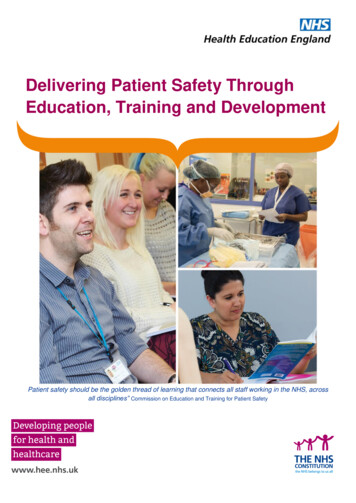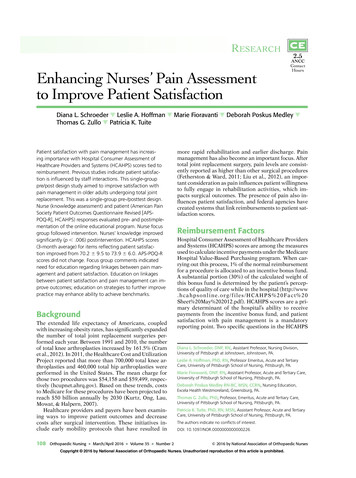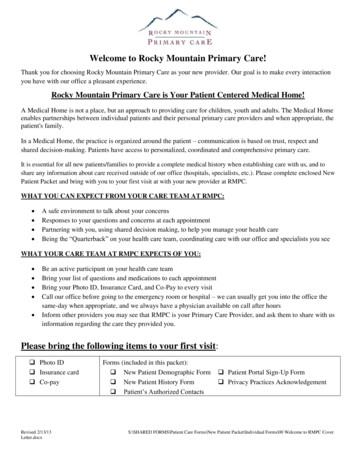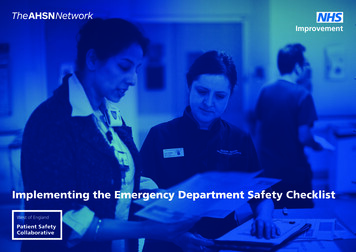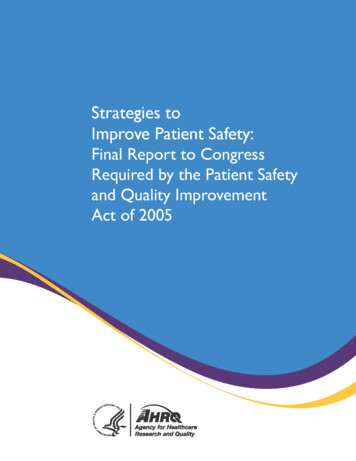
Transcription
Strategies to Improve Patient Safety:Final Report to Congress Required by thePatient Safety and Quality ImprovementAct of 2005U.S. Department of Health and Human ServicesSubmitted Under Contract HHSA2902014000091 byInsight Policy Research, Inc.Suggested CitationStrategies to Improve Patient Safety: Final Report to Congress Required by the Patient Safety andQuality Improvement Act of 2005. Rockville, MD: Agency for Healthcare Research and Quality;December 2021. AHRQ Publication No. 22-0009. trategies-improve-patient-safety-final.pdf.AHRQ Publication No. 22-0009November 2021
ContentsPreface . iExecutive Summary . iChapter 1. The Patient Safety and Quality Improvement Act of 2005: Overview of the Statute and ItsImplementation . 11.1. Impetus for and Objectives of the Patient Safety Act. 11.2. Key Provisions of the Patient Safety Act . 21.3. Implementation of the Patient Safety Act: 2005 to Present . 41.4. The Patient Safety Act: A National Learning System . 7Chapter 2. Strategies for Reducing Medical Errors and Increasing Patient Safety . 92.1. Scope and Terminology. 92.2. The Foundation for Effective Strategies: Some Fundamental Safety Principles and Concepts . 102.3. Designing and Testing the Strategies: Patient Safety Research. 122.4. Assessing the Effectiveness of Strategies: Measurement in Patient Safety . 182.5. Existing and Emerging Strategies for Reducing Medical Error and Increasing Patient Safety . 21Chapter 3. Encouraging the Use of Effective Strategies for Reducing Medical Errors and IncreasingPatient Safety . 333.1. Moving Patient Safety Strategies Into Practice: Key Concepts Supporting EffectiveImplementation . 333.2. Federal Resources That Support the Use of Effective Patient Safety Strategies . 343.3. The National Steering Committee for Patient Safety: Working to Align Efforts to Encourage theUse of Effective Patient Safety Strategies . 383.4. Encouraging Effective Patient Safety Improvement: What Works? . 403.5. Encouraging the Use of Effective Patient Safety Strategies . 44Appendix A: Recommendations from the National Academy of Medicine . A-1Appendix B: Development of the Draft Report and Public Comments .B-1TablesTable 1. Adverse Drug Events: General Medication Topics . 24Table 2. ADEs: Harms due to Anticoagulants. 24Table 3. ADEs: Harms due to Diabetic Agents . 24Table 4. ADEs: Reducing Adverse Drug Events in Older Adults . 25Table 5. ADEs: Harms Due to Opioids . 25
Table 6. ADEs: Infusion Pumps/Medication Error . 25Table 7. Alarm Fatigue . 25Table 8. Care Transitions . 26Table 9. Cross-cutting: Teamwork Training . 26Table 10. Cross-cutting: Health Information Technology . 26Table 11. Cross-cutting: Other Topics . 26Table 12. Delirium . 27Table 13. Diagnostic Error . 27Table 14. Failure to Rescue . 27Table 15. General Clinical Topics . 28Table 16. Infection Control: Carbapenem-Resistant Enterobacteriaceae . 28Table 17. Infection Control: Central Line-Associated Bloodstream Infections . 28Table 18. Infection Control: Clostridioides difficile Infection . 29Table 19. Infection Control: Infections Due to Other Multi-Drug-Resistant Organisms . 29Table 20. Infection Control: Miscellaneous Topics . 30Table 21. Infection Control: Urinary Tract Infection . 30Table 22. Patient and Family Engagement . 30Table 23. Patient Identification Errors . 31Table 24. Radiological . 31Table 25. Safety Practices for Hospitalized or Institutionalized Elders . 31Table 26. Sepsis Recognition . 31Table 27. Surgery, Anesthesia, and Perioperative Medicine . 32Table 28. Venous Thromboembolism . 32FiguresFigure 1. The Patient Safety and Quality Improvement Act of 2005: A National Learning System . 8Figure 2. Framework for Making Healthcare Safer III Report . 22Figure 3. Learning Health Systems . 33
PrefaceAs required by the Patient Safety and Quality Improvement Act of 2005 (Patient Safety Act),a theSecretary of the Department of Health and Human Services (HHS) has prepared this Final Report toCongress on effective strategies for reducing medical errors and increasing patient safety in consultationwith the Director of the Agency for Healthcare Research and Quality (AHRQ). It includes measuresdetermined appropriate by the Secretary to encourage the appropriate use of effective strategies forreducing medical errors and increasing patient safety, including use in federally funded programs. As thePatient Safety Act also required, a draft of this report was made available for public comment andsubmitted for review to the Institute of Medicine, now the National Academy of Medicine. This FinalReport, which is required to be submitted to Congress no later than December 21, 2021, includesupdates and additions made to address feedback received from members of the public and the NationalAcademy of Medicine.Executive SummaryThe report begins with an overview of the impetus for and objectives of the Patient Safety Act, its keyprovisions, and some milestones in its implementation. Currently, as a result of the Patient Safety Act,over 90 patient safety organizations (PSOs) are working with thousands of healthcare providers acrossthe country to improve patient safety and the quality of healthcare delivery.b This legislation alsorequired the Secretary to facilitate the creation of and maintain a network of patient safety databases(NPSD), which can leverage data contributed by these healthcare providers and PSOs into a valuablenational resource for improving patient safety.c The work of PSOs and providers under the Patient SafetyAct serves as a national learning system for patient safety improvement.The report reviews some of the principles and concepts underlying effective patient safetyimprovement, many of which stem from approaches to safety that grew in industries unrelated tohealthcare. It includes an overview of research and measurement in patient safety. The effectiveness ofa given patient safety improvement strategy or practice must be measured over time as it isimplemented in various healthcare settings. Measuring effectiveness in patient safety is complexbecause the problems and solutions are multifaceted and often context-dependent. Given thiscomplexity, applying traditional evidence-based medicine approaches to evaluating the effectiveness ofpatient safety improvement strategies presents some unique challenges.The strategies and practices for reducing medical errors and increasing patient safety presented in thisreport are those reviewed in AHRQ’s Making Healthcare Safer reports, published in 2001, 2013, andMarch 2020 (the latest edition reviewed literature published between 2008 and 2018, prior to the onsetof the COVID-19 pandemic). Together, these reports reviewed the existing evidence for theeffectiveness of more than 100 patient safety strategies and practices used in hospitals, primary carepractices, long-term care facilities, and other healthcare settings. These include cross-cutting strategiesand topics such as patient and family engagement and teamwork training; safety topics specific toparticular clinical interventions, such as medications and surgery; a variety of tools and processes, suchas rapid response teams and antimicrobial stewardship; and practices that target prevention of specificharms, such as healthcare-associated infections and pressure injuries. Hyperlinks lead to the full text ofthe evidence review and to later updates regarding the assessment of evidence for the effectiveness foreach strategy and practice. Scarcity of evidence at a given point in time does not necessarily equal lackof effectiveness. Conversely, the weight and direction of the evidence base can change as more studiesi
are conducted in different settings, the field’s understanding of patient safety expands, and newresearch is published.AHRQ, other Federal agencies, and nongovernmental organizations are important sources of tools,resources, and initiatives that encourage the use of effective patient safety improvement strategies.Moving effective patient safety improvement strategies into practice requires an understanding of thecontextual factors that might hinder or facilitate implementation. It must also take into account theneeds of the patients and healthcare providers who will be affected; the work structures, supportsystems, and organizational culture surrounding them; and the local resources and circumstances. Thereport describes an approach that has a track record of success in encouraging the use of evidencebased practices within a thoughtfully designed implementation framework that supports and improvessafety culture, teamwork, and communication.Several measures could accelerate progress in improving patient safety and encouraging the use ofeffective improvement strategies: Patient safety research, measurement, and practice improvement should encompass analyticapproaches that support learning from how and why things go right and how to monitor risk d,e,fwithout losing sight of the importance of addressing specific adverse events and harms. There is a continuing need for more research to develop the patient safety evidence basebecause safety is an important aspect of care for every patient in all healthcare disciplines,specialties, settings, and modes of healthcare delivery. Expanding the use of researchmethodologies that explore and capture the complexity of patient safety problems andsolutions will also advance the evidence base.g, h, i Translating evidence-based practices into real-world settings requires the development ofclinically useful tools and infrastructure and often foundational changes in organizationalculture, leadership and patient engagement, teamwork, and communication. Implementationmust be designed with and from the perspectives of the people who will be most affected andshould extend across the wide range of stakeholders who intend to support patient safety. Encouraging the development of learning health systems that integrate continuous learning andimprovement in their day-to-day operations can speed the application of the most promisingevidence to improve care. The concept of learning health systems can also facilitate theintegration of patient safety practices with functions necessary to achieve other priorities,including the effectiveness, timeliness, efficiency, patient-centeredness, and equity ofhealthcare. The National Action Planj put forth by the National Steering Committee for Patient Safety hasthe potential to advance and align efforts to encourage the use of effective patient safetystrategies. Many recommendations throughout the plan focus on ensuring that foundationalfactors are in place and sufficiently robust to enable the successful deployment and use ofstrategies and practices for reducing medical error and increasing patient safety.The work of federally listed PSOs and healthcare providers to reduce medical errors and increase patientsafety in various clinical settings and specialties is highly valued, successful, and thriving. A study of asample of Medicare-participating acute-care hospitals conducted by the Office of the Inspector Generalof the U.S. Department of Health and Human Servicesk in 2018 concluded that of hospitals that workwith a PSO, nearly all (97 percent) find it valuable, and half rated it as very valuable. Among the mostii
important reasons why hospitals choose to work with a federally listed PSO, according to the study, arethe opportunity to improve patient safety (94 percent cited this as very important in their decision towork with a PSO); the opportunity to learn from PSOs’ analysis of patient safety data (87 percent citedthis as very important); and the privilege and confidentiality protections (83 percent cited this as veryimportant). The study also noted that a majority (80 percent) of hospitals that work with a PSO reportedthat feedback and analysis on patient safety events had helped prevent future events, and nearly threequarters reported that such feedback had helped them understand the causes of events.To date, PSOs have voluntarily submitted over 2 million records to the NPSD, which is the datainfrastructure aspect of the Patient Safety Act. However, the NPSD’s ability to publicly release data isconstrained by limitations in the mechanisms currently available for data collection and the need toaccumulate a sufficient volume of data prior to public release in order to protect confidentiality. Thevoluntary nature of the system and corresponding need to minimize the burden of data submissionaffects the nature, volume, and quality of the data available to the NPSD. Existing technology that mightpermit remote collaboration between and among a broad array of networks without actuallytransferring data, such as distributed data networks,l has the potential to resolve some of theselimitations. Future advances in machine learning may enable evolution of the NPSD into a system thatcan accept unstructured or differently-structured data. Should any such new approaches to datainfrastructure and transmission become feasible, progress in building the NPSD into a morecomprehensive national patient safety learning system could be accelerated.Considering the voluntary nature of the Patient Safety Act, the number and diversity of providers andPSOs who choose this framework for patient safety improvement confirm the significance of this lawand its successful application. PSOs are making valuable contributions to the providers they work with,the safety of their patients, and the development of the NPSD as a resource for shared national learningabout patient safety. The landmark Patient Safety and Quality Improvement Act of 2005 created aunique and powerful framework that is supporting patient safety and quality improvement work acrossthe United States. That framework stands ready to support the collaborative national effort needed tomake further progress in improving the safety and quality of healthcare.Appendix A of this report addresses the specific recommendations made by the National Academy ofMedicine, which reviewed the December 2020 Draft Report as required by 42 U.S.C. § 299b-22(j)(1).Appendix B describes the actions taken by HHS to meet the statutory requirements for developmentand review of this report and provides an overview of comments on the December 2020 Draft Reportreceived from members of the public.EndnotesaThe requirement for the Draft Report can be found at 42 U.S.C. § 299b-22(j)(1); for the Final Report, 42 U.S.C. § 299b-22(j)(2).Agency for Healthcare Research and Quality. Patient safety organization (PSO) program: Federally-listed PSOs. https://pso.ahrq.gov/listed.Date accessed October 29, 2020.cAgency for Healthcare Research and Quality. NPSD: Network of patient safety databases. https://www.ahrq.gov/npsd/index.html. Dateaccessed October 29, 2020.dStevens JP, Levi R, Sands K. Changing the patient safety paradigm. J Patient Saf. 2019 Dec;15(4):288-289.doi: 10.1097/PTS.0000000000000394. PMID: 28691972.eFairbanks RJ, Wears RL, Woods DD, Hollnagel E, Plsek P, Cook RI. Resilience and resilience engineering in health care. Jt Comm J Qual PatientSaf. 2014 Aug;40(8):376-83. doi: 10.1016/s1553-7250(14)40049-7. PMID: 25208443.fBraithwaite J. Changing how we think about healthcare improvement. BMJ. 2018 May 17;361:k2014. doi: 10.1136/bmj.k2014. PMID:29773537; PMCID: PMC5956926.biii
gDavidoff F. Improvement interventions are social treatments, not pills. Ann Intern Med. 2014 Oct 7;161(7):526-7. doi: 10.7326/M14-1789.PMID: 25285545.hWebster CS. Evidence and efficacy: time to think beyond the traditional randomised controlled trial in patient safety studies. Br J Anaesth.2019 Jun;122(6):723-725. doi: 10.1016/j.bja.2019.02.023. Epub 2019 Apr 4. PMID: 30954239.iDixon-Woods M, Bosk CL, Aveling EL, Goeschel CA, Pronovost PJ. Explaining Michigan: developing an ex post theory of a quality improvementprogram. Milbank Q. 2011 Jun;89(2):167-205. doi: 10.1111/j.1468-0009.2011.00625.x. PMID: 21676020; PMCID: PMC3142336.jNational Steering Committee for Patient Safety. Safer Together: A National Action Plan to Advance Patient Safety. Boston, Massachusetts:Institute for Healthcare Improvement. http://www.ihi.org/SafetyActionPlan. Date accessed October 29, 2020.kOffice of the Inspector General of the Department of Health and Human Services. Patient safety organizations: hospital participation, value,and challenges. OEI-01-17-00420. September 2019. flCurtis LH, Brown J, Platt R. Four health data networks illustrate the potential for a shared national multipurpose big-data network. Health Aff(Millwood). 2014 Jul;33(7):1178-86. doi: 10.1377/hlthaff.2014.0121. PMID: 25006144.iv
Chapter 1.The Patient Safety and Quality Improvement Act of 2005:Overview of the Statute and Its Implementation1.1.Impetus for and Objectives of the Patient Safety ActRecommendations made by the Institute of Medicine (IOM, now the National Academy of Medicine) inits landmark report To Err Is Human: Building a Safer Health Care System1 (referred to here as the IOMReport) were the impetus for the Patient Safety and Quality Improvement Act of 2005 (Patient SafetyAct).2 The IOM Report brought attention to the problem of adverse events in the U.S. healthcare system,and it issued a call to action to incorporate safety principles used in other high-risk industries to makehealthcare safer.The IOM Report encouraged the promotion of voluntary reporting by healthcare providers but alsonoted that fear of legal discovery was a significant barrier. Because existing laws offered limitedprotection for information related to patient safety and quality improvement efforts and often did notapply when such information was shared beyond a single institution, action was needed to “encouragehealth care professionals and organizations to identify, analyze, and prevent errors without increasingthe threat of litigation and without compromising patients’ legal rights.”3 The IOM Report thereforeincluded a recommendation that “Congress should pass legislation to extend peer review protections todata related to patient safety and quality improvement that are collected and analyzed by health careorganizations for internal use or shared with others solely for purposes of improving safety andquality.”4Consistent with this recommendation, the Patient Safety Act created a framework for the developmentof a voluntary patient safety event reporting system to advance patient safety and quality of care acrossthe Nation.5 Without limiting patients’ rights to their medical information, the law created Federal legalprivilege and confidentiality protections for patient safety work product; that is, information that wouldbe exchanged between healthcare providers and organizations specializing in patient safety and qualityimprovement, called patient safety organizations (PSOs). The law charged PSOs with analyzing and usingthis information to provide feedback and assistance to help providers minimize patient risk and improvethe safety and quality of their care.In addition to creating a protected legal environment where healthcare providers can share informationand learning for improvement purposes beyond organizational and State boundaries, Congress alsoenvisioned and created the potential for aggregating and analyzing patient safety data on a nationalscale. This part of the Patient Safety Act, the network of patient safety databases (NPSD), is a1Institute of Medicine (US) Committee on Quality of Health Care in America. To Err Is Human: Building a Safer Health System. Kohn LT, CorriganJM, Donaldson MS, editors. Washington (DC): National Academies Press (US); 2000. PMID: 25077248.2Patient Safety and Quality Improvement Act of 2005, Pub. L. No. 109-41, 119 Stat. 424, codified at 42 U.S.C. sections 299b–21 through 299b–26.3Institute of Medicine (US) Committee on Quality of Health Care in America. To Err Is Human: Building a Safer Health System. Kohn LT, CorriganJM, Donaldson MS, editors. Washington (DC): National Academies Press (US); 2000;112. PMID: 25077248.4Institute of Medicine (US) Committee on Quality of Health Care in America. To Err Is Human: Building a Safer Health System. Kohn LT, CorriganJM, Donaldson MS, editors. Washington (DC): National Academies Press (US); 2000;111. PMID: 25077248.5H.R. Rep. No. 109–197. Patient Safety and Quality Improvement Act of 2005. 2005;9. rpt197.pdf1
mechanism that can leverage data contributed by individual healthcare providers and PSOs across theUnited States into a valuable national resource for improving patient safety.The Patient Safety Act has been compared to programs that perform specified safety reporting andimprovement functions for an entire industry or national healthcare system, such as the Aviation SafetyReporting System (ASRS) and the VA National Center for Patient Safety. Such systems operate under asingle national directive that applies uniformly to all participants and have a single, centralized locus forreceipt and analysis of all reports. In the case of ASRS, reports are submitted directly by individualpersonnel. The Patient Safety Act created a very different structure for supporting national learning andimprovement. Unlike such centralized safety reporting systems, Congress designed the Patient SafetyAct national learning system using a market-based approach that works by “allowing the healthcareindustry to voluntarily avail itself of this framework in the best manner it determines feasible.6 PSOs areneither funded nor controlled by the Federal Government; this is a learning system that “ allows themarketplace to be the principal arbiter of the capabilities of each PSO.”7 It is shaped by the diverseexpertise, creativity and business plans of the entities that seek PSO listing and the providers they serve,the particular patient safety and quality improvement services they offer, and the healthcare providersthat choose to engage particular PSO services that would not be undertaken without the Patient SafetyAct protections. Across the country, PSOs are receiving, analyzing, and aggregating patient safety workproduct from the providers they serve and are engaging in patient safety improvement work with them,often across settings. The nature of the data they generate depends on the nature of the data providers(typically entities rather than individual healthcare personnel) choose to submit and the particular focusof the improvement work undertaken by the PSO and its reporting providers. PSOs that work withproviders using the AHRQ Common Formats may volunteer to contribute nonidentified data to populatethe NPSD, but they are not required to do so.1.2. Key Provisions of the Patient Safety ActThis section provides an overview of the statutory structure and content for reference and to providecontext for the report.1.2.1. Definitions (Codified at 42 U.S.C. § 299b-21)Several of the definitions in this section, unique to the statute, are central to understanding how itoperates; for example, patient safety work product, patient safety activities, patient safety evaluationsystem, and provider.1.2.2. Privilege and Confidentiality Protections (Codified at 42 U.S.C. § 299b-22)The confidentiality and privilege protections afforded by the Patient Safety Act only apply when aprovider works with a federally listed PSO. Notwithstanding any other provision of Federal, State, orlocal law, information that meets the definition of patient safety work product is privileged andconfidential and may only be disclosed consistent with an applicable statutory exception. Civil moneypenalties may be imposed for knowing or reckless violations of the confidentiality requirements.Individuals are protected from adverse employment actions by providers for having made a good faithreport intended for a patient safety organization, and providers that take advantage of theconfidentiality provisions are protected from certain adverse actions by accrediting bodies. The6Department of Health and Human Services. 42 CFR Part 3: Patient Safety and Quality Improvement. Notice of Proposed Rulemaking. 73 FR8111; February 12, 2008, at 8114. Department of Health and Human Services. 42 CFR Part 3: Patient Safety and Quality Improvement. Notice of Proposed Rulemaking. 73 FR8111; February 12, 2008, at 8126. Date accessed August 27, 2021.2
Department of Health and Human Services’ (HHS) Office for Civil Rights has been delegated certainauthorities under the Patient Safety Act, including the authority “to make decisions regardinginterpretation and enforcement of the privilege and confidentiality protections ” of the Patient SafetyAct.8The Patient Safety Act includes a Rule of Construction that makes it clear that the Act does not limit theapplication of laws that provide greater privilege or confidentiality protections or affect any Federal,State, or local laws pertaining to information not protected under the Patient Safety Act. The Rule ofConstruction also explicitly states that the Patient Safety Act does not preempt or affect State laws thatrequire providers to report information that is not patient safety work product or affect or limit anyFood and Drug Administration (FDA) reporting requirements. Clarification is provided on how the HealthInsurance Portability and Accountability Act’s confidentiality regulations apply to PSOs and patientsafety activities conducted under the Patient Safety Act. Another provision clar
the country to improve patient safety and the quality of healthcare delivery. b. This legislation also required the Secretary to facilitate the creation of and maintain a network of patient safety databases (NPSD), which can leverage data contributed by these healthcare providers and PSOs into a valuable national resource for improving patient .
